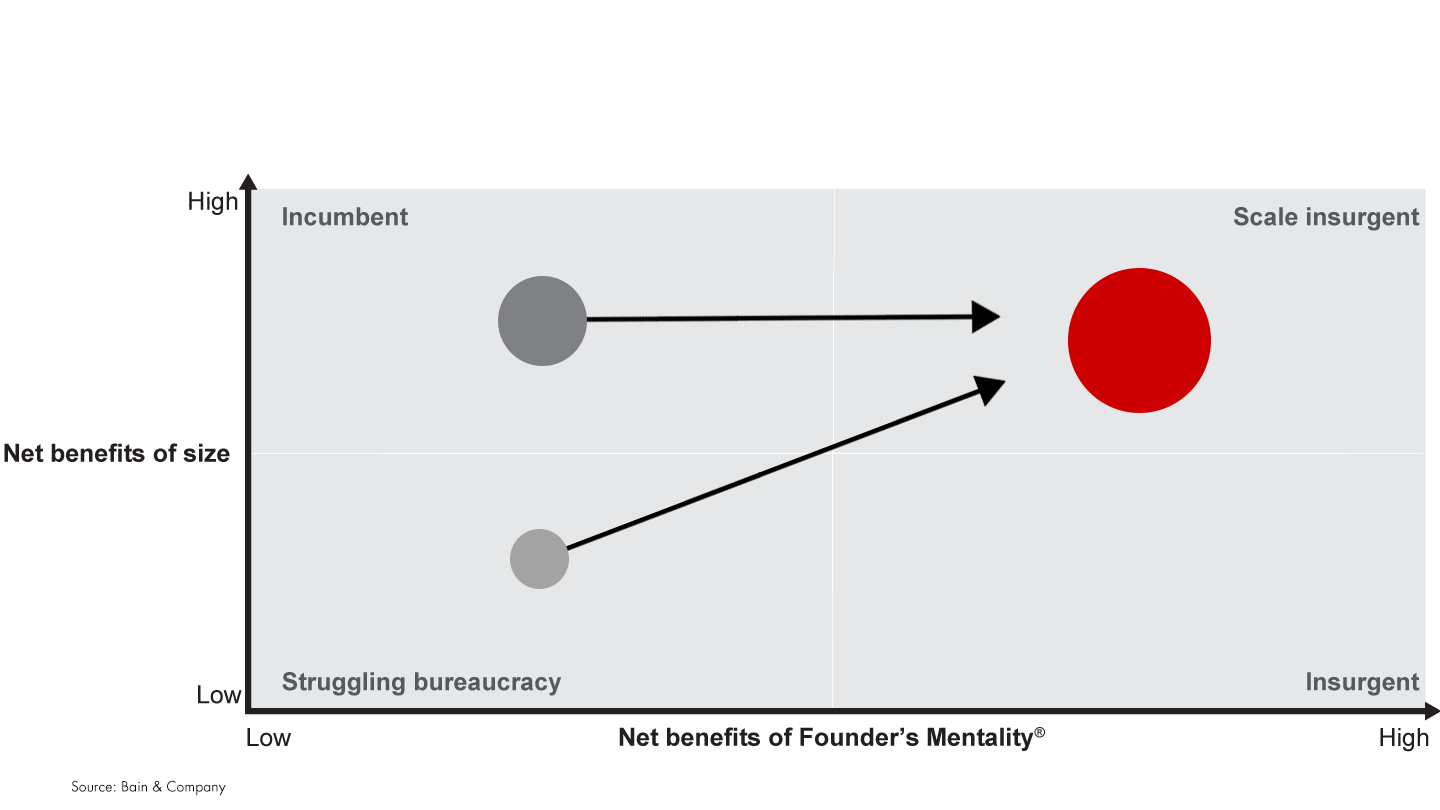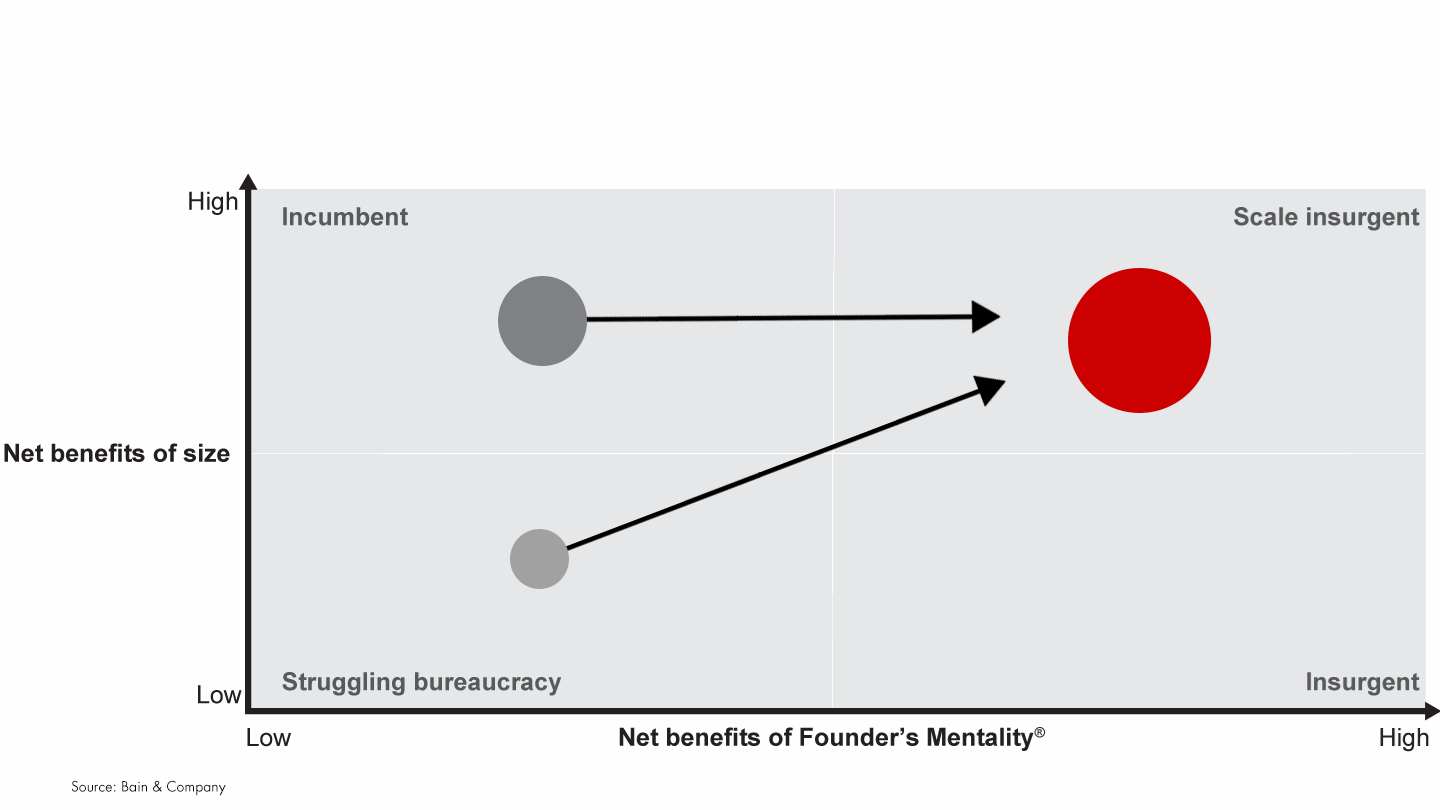Founder's Mentality Blog
The resources of large global companies are the envy of any start-up. These large incumbents enjoy the benefits of scale: They have the market leadership, assets and scope they need to out-invest competitors, hire top talent and serve their customers better than anyone else.


For start-ups, the goal is clear: Achieve the same scale so they can compete with these behemoths. This is also why incumbents work hard to retain their industry positions. As we outlined in the book Profit from the Core, scale and scope are often critical to achieving sustainable growth and leadership in an industry.
But scale and scope can come with a cost. Entrepreneurial companies often regret the trade-offs they make as they grow: the loss of an ownership culture, a reduced focus on customers and the growth of complexity. In short, they begin to lose the Founder’s Mentality® behind their original success.
CEOs of large incumbents also feel nostalgia for the good old days. Sitting atop the vast global enterprises that are the envy of start-ups, they long for simplicity, for a better connection with the front line and for the voice of the customer to be better represented in corporate debates.

About the Founder's Mentality
The three elements of the Founder's Mentality help companies sustain performance while avoiding the inevitable crises of growth.
Of course, for many leaders, this loss of Founder’s Mentality might seem like an acceptable trade-off if it gives their companies the scale and scope needed to dominate their industries. But companies cannot hover in place. No matter their size or resources, incumbents eventually sink under the weight of their own complexity—pulled down until they become struggling bureaucracies that have not only lost their Founder’s Mentality, but begin to lose the net benefits of scale and scope.
What pulls them down? Just as predictable forces—the westward winds—cause insurgents to lose their Founder's Mentality as they grow, another set of predictable forces turns the power of incumbency into the pain of bureaucracy. We call these forces the southward winds.
- The complexity doom loop. With growth comes complexity, yet most efforts to manage that new complexity—reorganizations, new processes, new systems—simply layer it on.
- Death of the nobler mission. Once they dominate their industry, incumbents can easily lose the shared sense of mission that comes so naturally to industry challengers. Bloodless metrics begin to replace real strategy as the company focuses on defending the status quo.
- The curse of the matrix. A healthy matrix organization encourages—and quickly resolves—the necessary conflicts and trade-offs between those responsible for realizing the benefits of scale and those whose job is to advocate for customer needs, tailored products, local marketing and so on. But as organizations grow larger, this healthy tension sometimes breaks down. The points of interaction—the nodes—between these two sides proliferate, and each is populated by people whose job seems to be to say “no” instead of achieving fast resolution. The founder’s clarity—there are those who sell and those who support those who sell—is lost in a sea of competing interests.
- Fragmentation of the customer experience. The rise of the middle management planner focuses too much attention on process and templates, and signals the end of a healthy conversation about what really matters for the company's future: delighting the customer. As the different departments responsible for delivering various elements of the customer experience stop speaking to one another, the customer experience becomes increasingly fragmented.
In and of itself, incumbency is not a problem—it offers companies tremendous resources and benefits. But these southward winds are very real, and without a Founder’s Mentality, they constantly threaten to push an incumbent south until it becomes a struggling bureaucracy.
The path for incumbents and struggling bureaucracies is clear: Maintain, or recreate, the benefits of scale and rediscover the Founder’s Mentality. We think this is best done through Repeatable Models®:
- Focus. Bring back the voice of the customer and the voice of the front line to focus on what your company does at its best. What is it that you do that is truly unique and differentiated for your core customers, and which can be made scalable, transferable and repeatable across your organization?
- Embed. Collaborate with your front line to turn that repeatable model into a nobler mission and a set of routines and nonnegotiables to ensure the front line can deliver the repeatable model every day to every customer.
- Adapt. Build in the right feedback loops to make sure you are in a constant state of insurgency, consistently responding to customers and competitors' offerings, and continually delivering the future not fighting it.

Path Three: Restoring Founder's Mentality® through Creative Partnerships
Creative partnerships with fast-growing, Agile companies can help large incumbents regain their Founder's Mentality.
Founder's Mentality®, Great Repeatable Models® and Repeatable Models® are registered trademarks of Bain & Company, Inc.